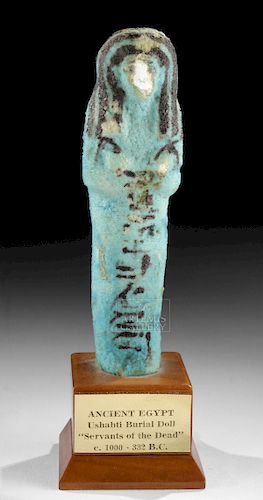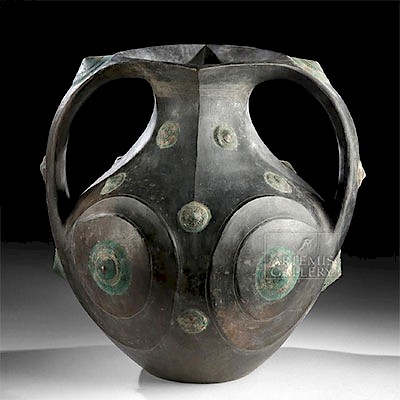Egyptian Third Intermediate Faience Ushabti
Lot 10
About Seller
Artemis Fine Arts
686 S Taylor Ave, Ste 106
Louisville, CO 80027
United States
Selling antiquities, ancient and ethnographic art online since 1993, Artemis Gallery specializes in Classical Antiquities (Egyptian, Greek, Roman, Near Eastern), Asian, Pre-Columbian, African / Tribal / Oceanographic art. Our extensive inventory includes pottery, stone, metal, wood, glass and textil...Read more
Estimate:
$900 - $1,400
Absentee vs Live bid
Two ways to bid:
- Leave a max absentee bid and the platform will bid on your behalf up to your maximum bid during the live auction.
- Bid live during the auction and your bids will be submitted real-time to the auctioneer.
Bid Increments
| Price | Bid Increment |
|---|---|
| $0 | $25 |
| $300 | $50 |
| $1,000 | $100 |
| $2,000 | $250 |
| $5,000 | $500 |
| $10,000 | $1,000 |
| $20,000 | $2,500 |
| $50,000 | $5,000 |
| $100,000 | $10,000 |
| $200,000 | $20,000 |
About Auction
By Artemis Fine Arts
Jul 11, 2019
Set Reminder
2019-07-11 10:00:00
2019-07-11 10:00:00
America/New_York
Bidsquare
Bidsquare : Ancient / Ethnographic / Americana
https://www.bidsquare.com/auctions/artemis-gallery/ancient-ethnographic-americana-4246
Discover ancient art from Egypt, Greece, Italy, and the Near East, as well as Asian, Pre-Columbian, Tribal, Fossils and Fine Art. Also featuring a wonderful collection from a prominent New York estate whose owners reside in the Van Wyck family's historic Lloyd Harbor waterfront home. Artemis Fine Arts info@artemisgallery.com
Discover ancient art from Egypt, Greece, Italy, and the Near East, as well as Asian, Pre-Columbian, Tribal, Fossils and Fine Art. Also featuring a wonderful collection from a prominent New York estate whose owners reside in the Van Wyck family's historic Lloyd Harbor waterfront home. Artemis Fine Arts info@artemisgallery.com
- Lot Description
Ancient Egypt, Third Intermediate Period, 21st to 25th Dynasty, ca. 1070 to 664 BCE. A fine mold-formed faience ushabti covered in brilliant cornflower-blue glaze and decorated with applied black pigment. The figure stands in mummiform atop fused legs, holds the symbolic pick and hoe in hands crossed atop the chest, and has a small seed bag draped across the back. Traces of the black-painted eyes, cupped ears, and false beard are visible on the face despite heavy abrasions, and the head is covered with a tripartite wig boasting thick black-painted stripes. A painted column of hieroglyphic symbols graces the front of the legs and, while untranslated, would provide the name of Osiris as well as the name of the deceased. Size: 1.2" W x 4.2" H (3 cm x 10.7 cm); 5.55" H (14.1 cm) on included custom stand.
Shabti (or ushabti) dolls are figures shaped like adult male or female mummies wearing traditional ancient Egyptian headdresses. The ancient Egyptians believed that after they died, their spirits would have to work in the "Field of Reeds" owned by the god of the underworld, Osiris. This meant doing agricultural labor was required by all members of society, from workers to pharaohs. By the Third Intermediate period, this practice had become so necessary and elaborate that some tombs contained one worker for every day of the year and thirty-six overseers, each responsible for ten laborers. The wealthier nobility in Egyptian society were able to have shabtis made of coveted faience, and blue faience was meant to reflect the color of the river Nile both on earth and in the afterlife.
Provenance: ex-Hilja K. Herfurth collection, Denver, Colorado, USA
All items legal to buy/sell under U.S. Statute covering cultural patrimony Code 2600, CHAPTER 14, and are guaranteed to be as described or your money back.
A Certificate of Authenticity will accompany all winning bids.
We ship worldwide and handle all shipping in-house for your convenience.
#147242Figure is adhered to display stand and cannot be removed. Repaired from multiple pieces with restoration and overpainting along break lines. Abrasions and minor nicks to legs, body, and face, with fading to original blue and black pigmentation, light encrustations, and some small areas of pitting. Light earthen deposits throughout. Label on front of display stand reads, "ANCIENT EGYPT Ushabti Burial Doll "Servants of the Dead" c. 1000 - 332 B.C."Condition
- Shipping Info
-
All shipping is handled in-house for your convenience. Your invoice from Artemis Gallery will include shipping calculation instructions. If in doubt, please inquire BEFORE bidding for estimated shipping costs for individual items.
-
- Buyer's Premium



 EUR
EUR CAD
CAD AUD
AUD GBP
GBP MXN
MXN HKD
HKD CNY
CNY MYR
MYR SEK
SEK SGD
SGD CHF
CHF THB
THB














